This or That: Chamomile — Which one do you choose?
Oct 26th 2023
Posted by Dr. Christoph Streicher and Chase F.
It’s hard to pinpoint just how long ago people began using Chamomile. Ancient Egyptians gave us the oldest known references to the plant, but it is widely believed that use of Chamomile is probably much older than any evidence we are aware of today. We also know that Ancient Greek, Ancient Spanish, and Ancient Chinese cultures understood its therapeutic qualities. Chamomile has even been regarded as the “plant’s physician,” having demonstrated its uncanny ability to “heal” other plants in the immediate area.* However, the multitude of its varieties sometimes leads to confusion. One perplexing example includes Blue Moroccan Chamomile, which is not technically a chamomile at all, but instead a tansy.
In the world of essential oils, the differences between Chamomile species are significantly important. Each variety contains its own distinctive chemical makeup which can alter the effects experienced by its users. Amrita Aromatherapy offers these types of Chamomile Essential Oil: Roman, German Blue, German CO₂, and Blue Moroccan Chamomile. As mentioned already, Blue Moroccan Chamomile is somewhat of a misnomer, as it is not actually classified as a “true” chamomile. Therefore, this article will focus on two distinct and popular species: Roman Chamomile and German Chamomile.
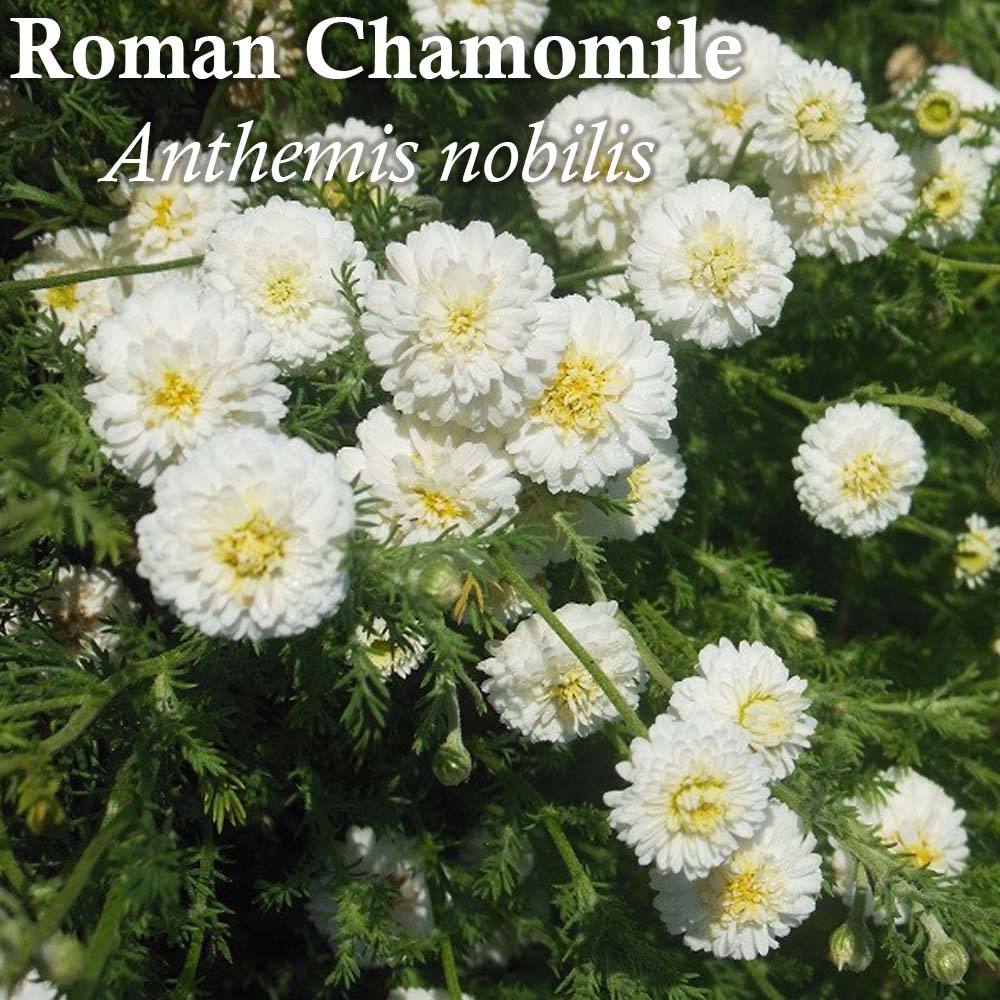 | 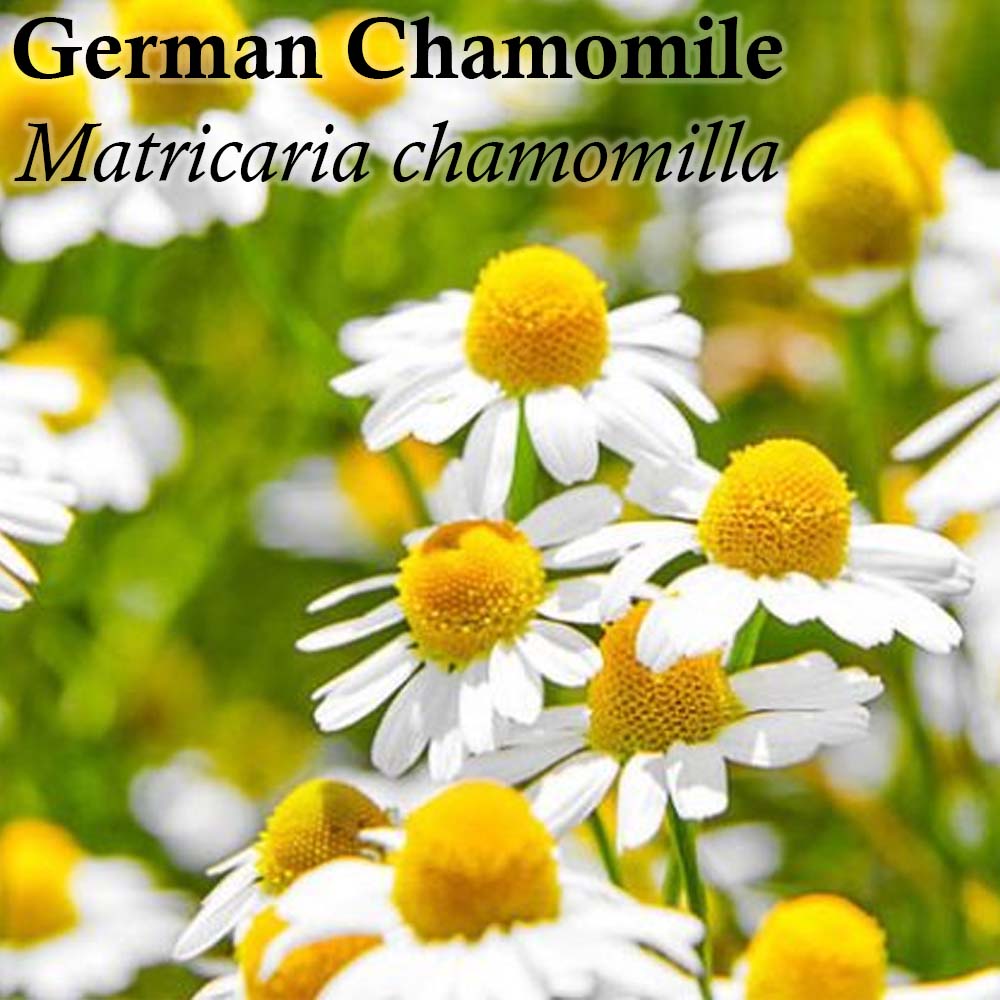 | 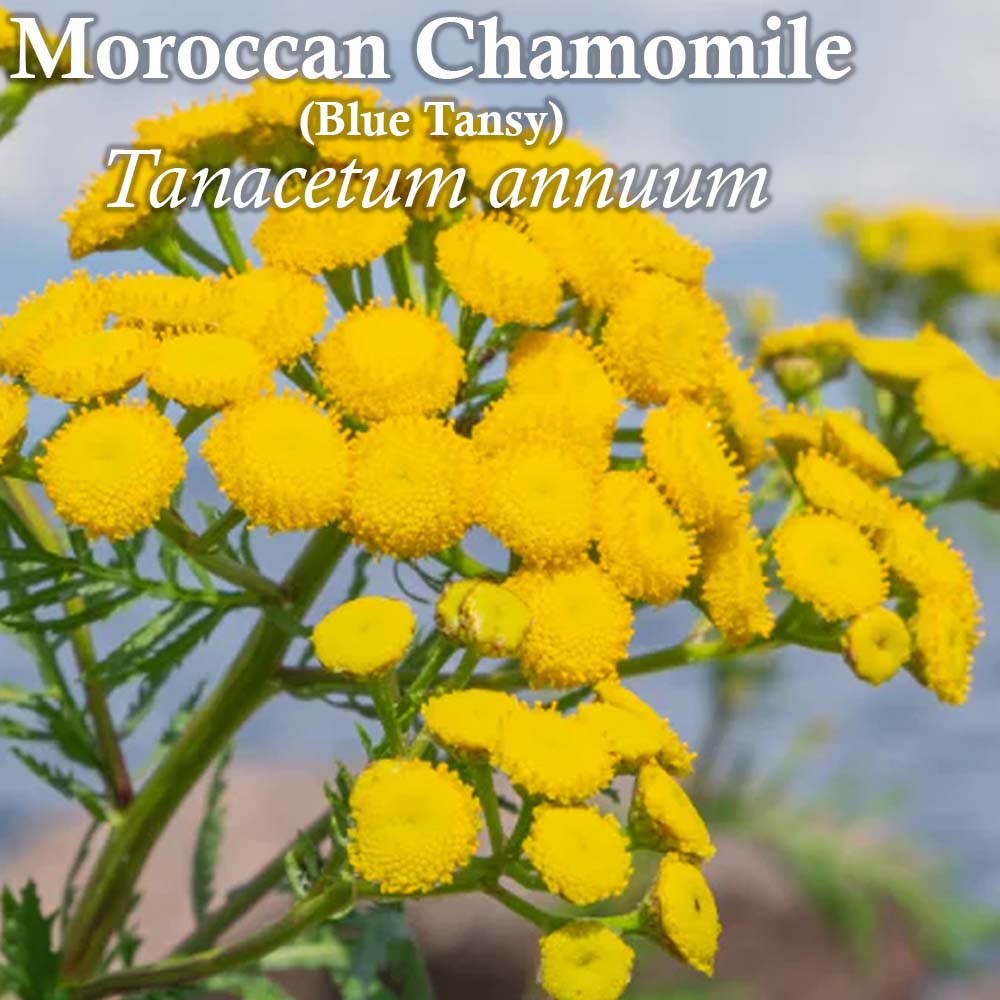 |
What is the difference between Roman & German Chamomile? What about CO₂ German?
For therapeutic use, two species of Chamomile stand out as the most sought after: Roman (Anthemis nobilis) and German (Matricaria chamomilla). Though they have their similarities, the Roman species is known to grow very close to the ground while German Chamomile can grow up to 2 feet tall. The aroma of Roman Chamomile is described as having a “light, fresh-apple fragrance,” while the German variety lends itself more toward “sweet straw.” Another way to distinguish between the two plants is that the Roman species contains hollow cones while the German does not. Also, Roman Chamomile is a perennial, while German Chamomile is an annual needing yearly replanting. Both have been used extensively in herbal teas, but German Chamomile is often preferred due to its less bitter profile.
When considering the essential oils of these two plants, it is their chemical composition which sets them apart. Simply put, Roman Chamomile provides spasmolytic and antispasmodic actions which are simply unrivaled, even by its close German relative. So much so, in fact, that it is comparable in efficacy to synthetic drugs and is even known to help stop acute asthma attacks. On the other hand, German Blue Chamomile exhibits unrivaled anti-inflammatory abilities more potently than its Roman counterpart. Both species retain some overlap in these therapeutic benefits, but each is stronger pertaining to specific actions.
Without getting too far in the weeds, the most unique compound to German Blue Chamomile Essential Oil is a dark-blueish substance called chamazulene. This substance does not occur naturally within the plant but happens when matricarin is converted to chamazulene during the process of steam distillation. Chamazulene is understood to imbue German Blue Chamomile Essential Oil with unequaled anti-inflammatory and anti-allergenic actions, making it a great option for topical pain relief.* There is also a method of essential oil extraction which utilizes CO₂ (Carbon Dioxide) to create an ultra-pure, thicker oil, leaving even more of the plant’s active chemicals intact and unaltered. Therefore, German CO₂ Chamomile Essential Oil is even more potent than steam-distilled German Chamomile Essential Oil, while simultaneously offering a milder aroma.*
Because of the chemical differences between Amrita’s Roman Chamomile Essential Oil, German Blue Essential Oil, and German CO₂ Essential Oil, each product finds itself with distinct advantages for its users depending on their desired outcome. Please note, Blue Moroccan Chamomile is excluded from this chart because it is technically classified as a tansy, not a chamomile. It does have some overlapping benefits, however, and contains chamazulene just as the German variety does. Therefore, dear reader, Amrita encourages you to separately research Blue Moroccan Chamomile Essential Oil. It has only been left out of this article because scientifically it belongs to another species altogether, not because of any lack of merit on its part.
Below is a chart which breaks them down by category:
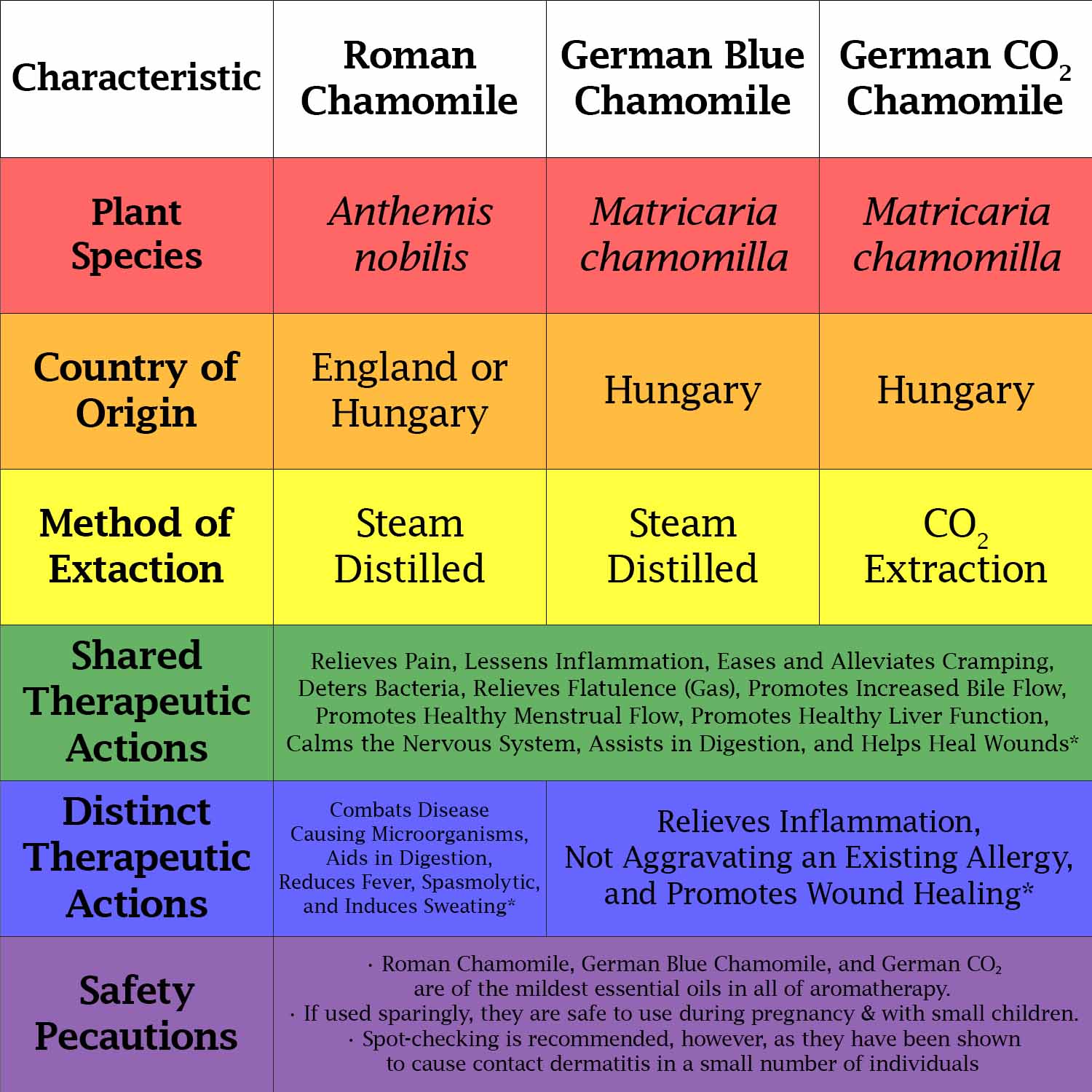
Trying to figure out how to use Chamomile? Here’s a cheat sheet!
Roman and German varieties of Chamomile can both be used by applying topically or by diffusion & inhalation. Amrita’s experts do want you to know: German Chamomile cannot be used in a nebulizer as it will clog it. However, each kind maintains advantages depending upon the method of application. As mentioned in the chart above, these varieties are quite mild and even can be safely utilized by pregnant women and small children if used sparingly.* An example could be for teething children, a 1-2% dilution of either the Roman or German species of Chamomile (5-10 drops per tablespoon of carrier oil) can be applied gently to the cheeks, and for colicky babies the same dilution could be applied gently to the abdomen.* Keep in mind that the chart specifically excludes Blue Moroccan Chamomile. Not only is the Blue Moroccan variety classified as a tansy, not a chamomile despite its name, but it also contains ketones.* Thus, it is not recommended for pregnant women, babies, small children, or those breastfeeding.* This might be the most important distinction between the “actual” chamomiles and Blue Moroccan Chamomile (tansy).
- Overall Topical Application: When using Chamomile topically (directly on the skin), it is always important to properly dilute the oil first. Roman Chamomile Essential Oil can be applied topically with a dilution of up to 5-10% (25 to 50 drops per tablespoon of carrier oil, such as Jojoba or Hazelnut). It is milder than the German varieties but offers distinct abilities to help reduce cramping, induce sweating, stimulate appetite, and reduce fever.* It also works great as an antiseptic skin cleanser!* German varieties of Chamomile Essential Oil can also be applied topically but should be diluted to 2% (only 10 drops per tablespoon of carrier oil). Topical use of German Chamomile oil is highly effective for spot-treatment of skin wounds, bug bites, or anywhere pain persists due to its high levels of chamazulene, which is discussed previously in this article.*
- Whole-Body Massage Application: Roman Chamomile and German Chamomile can both be applied via massage oil as well, given they are both properly diluted. Roman Chamomile Essential Oil should be diluted to 2-7% (10-35 drops per tablespoon of carrier oil) for this method while the recommended dilution for the German Blue and German CO₂ varieties remains at no more than 2% (10 drops per tablespoon of carrier oil). This method is a way to apply Chamomile more broadly, as opposed to focusing on specific areas of need. See the chart above for which therapeutic benefits are more likely to be achieved by each kind and method.*
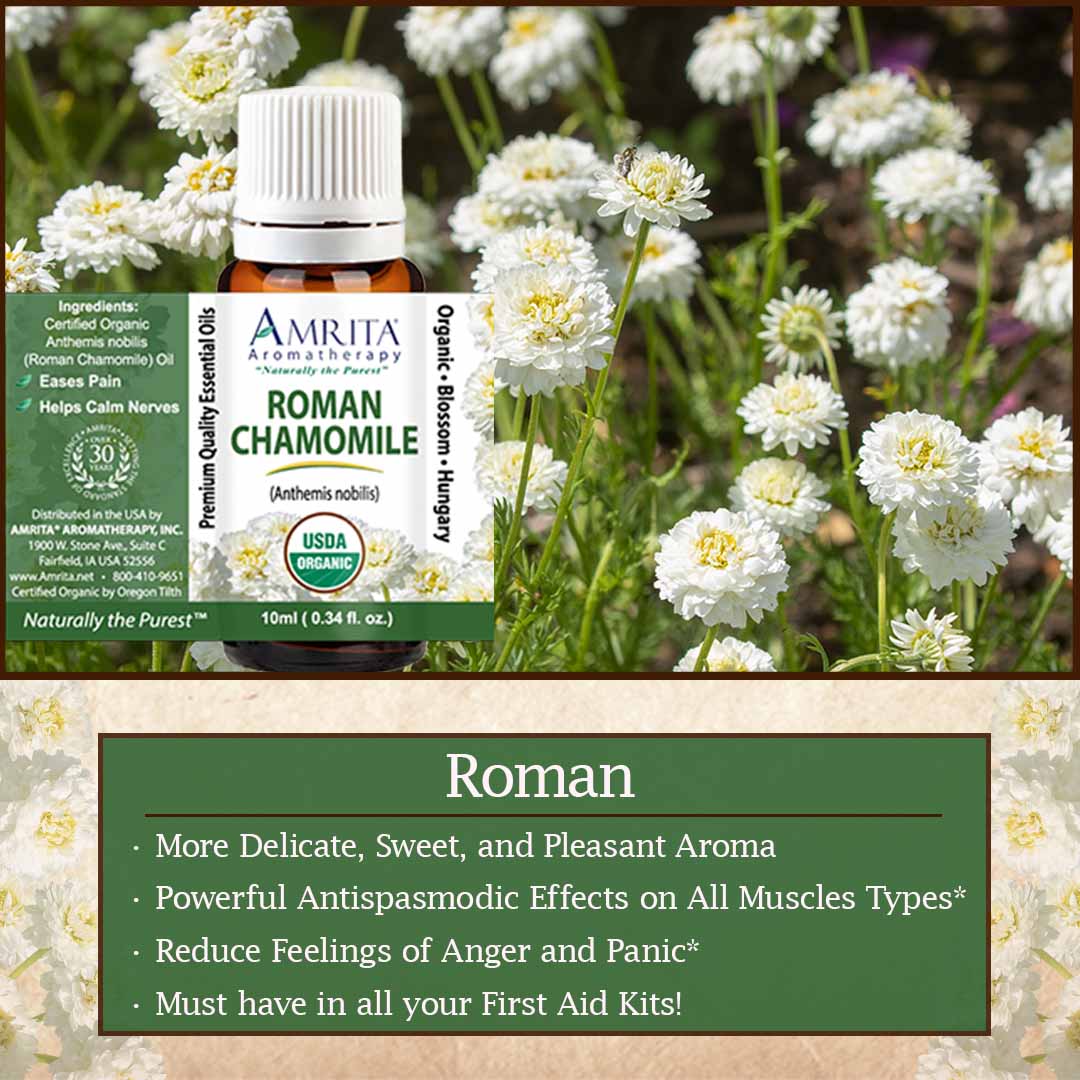 | 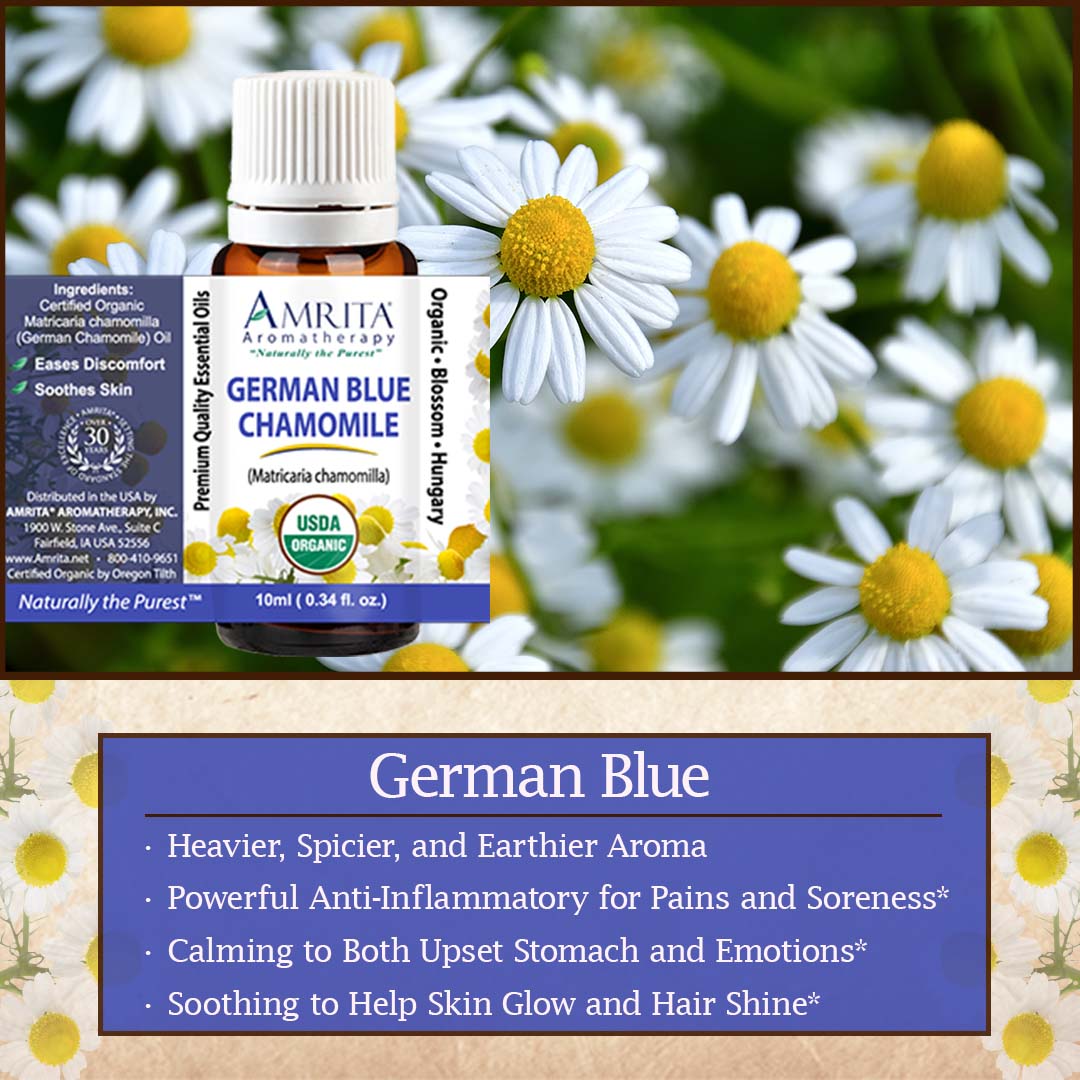 |  |
- Aromatic Bath Application: A soothing way to enjoy the sedative properties of both Roman Chamomile and German Chamomile is to apply via aromatic bath. Choosing between the species of Chamomile for this method simply requires the user to assess their personal needs based on the above chart which breaks down the various therapeutic actions of each variety.* Roman Chamomile, also known as “bath chamomile” to some, has a more elegant aroma and provides spasmolytic action which can’t be obtained from German varieties.* German CO₂ displays a milder aroma than that of regular German Blue while delivering more anti-inflammatory action than both the steam distilled German and the Roman variety.* Whichever you choose, simply add a few drops to bath salts or bath milk before adding to a full, warm, tub of water.
- Diffusion / Inhalation: Another way to enjoy the relaxing effects of Roman Chamomile is to add a few drops to your favorite nebulizer or inhaler, though the German varieties cannot be used in nebulizers due to potential clogging issues. German varieties of Chamomile can be used in a nasal inhaler, however. Known to calm the nerves, relieve stress, and deter insomnia, there is perhaps no other offering of nature so soothing.*
What blends well with each variety of Chamomile?
Roman Chamomile and German Blue Chamomile both blend well with a broad range of other oils. Try pairing the fresh, warm-sweet, fruity aroma of Roman Chamomile Essential Oil with Lavender and Rose Geranium for a spectacularly floral bouquet. If a feeling of balance is the goal, the similar yet more potent aroma of German CO₂ Chamomile will cordially join with Lavender and Lemongrass to provide some much-needed stability for the nervous system.* For an even more powerful calm, tackle the stress of a challenging day with a blend of German Blue Chamomile, Lemongrass, Rose Geranium, Citronella, and Patchouli to achieve some much-deserved respite.*
Here are some popular DIY recipes for you to try at home:
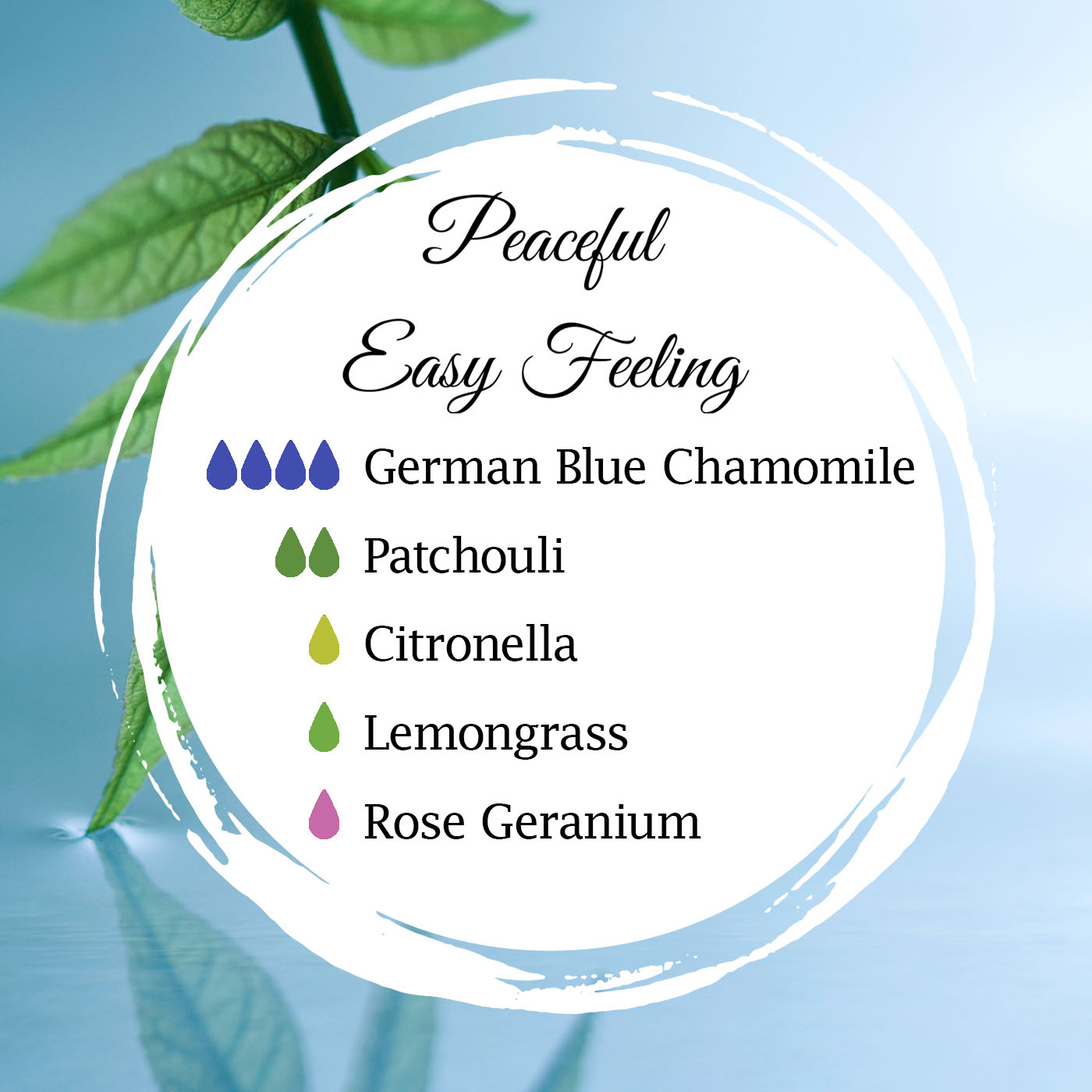 | 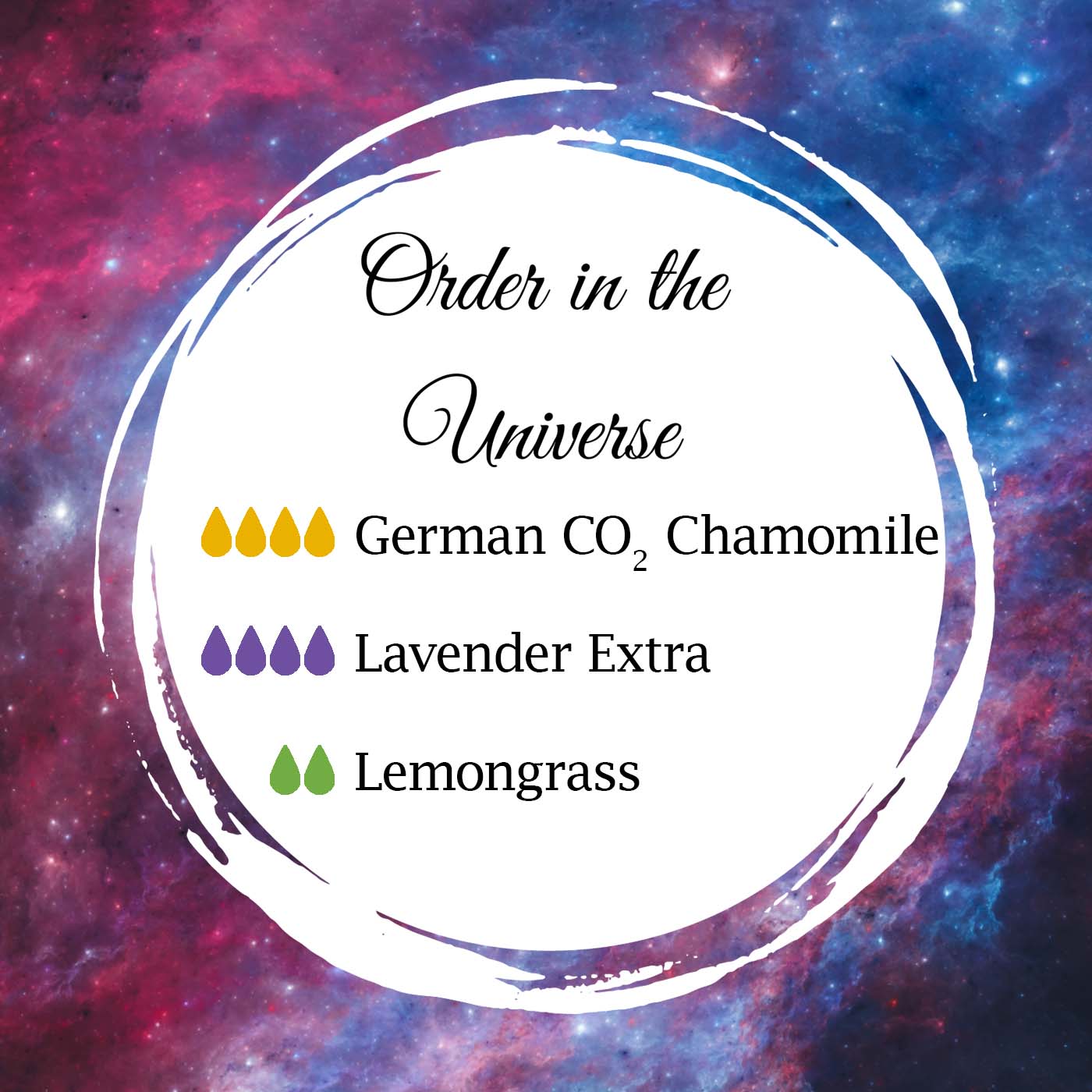 | 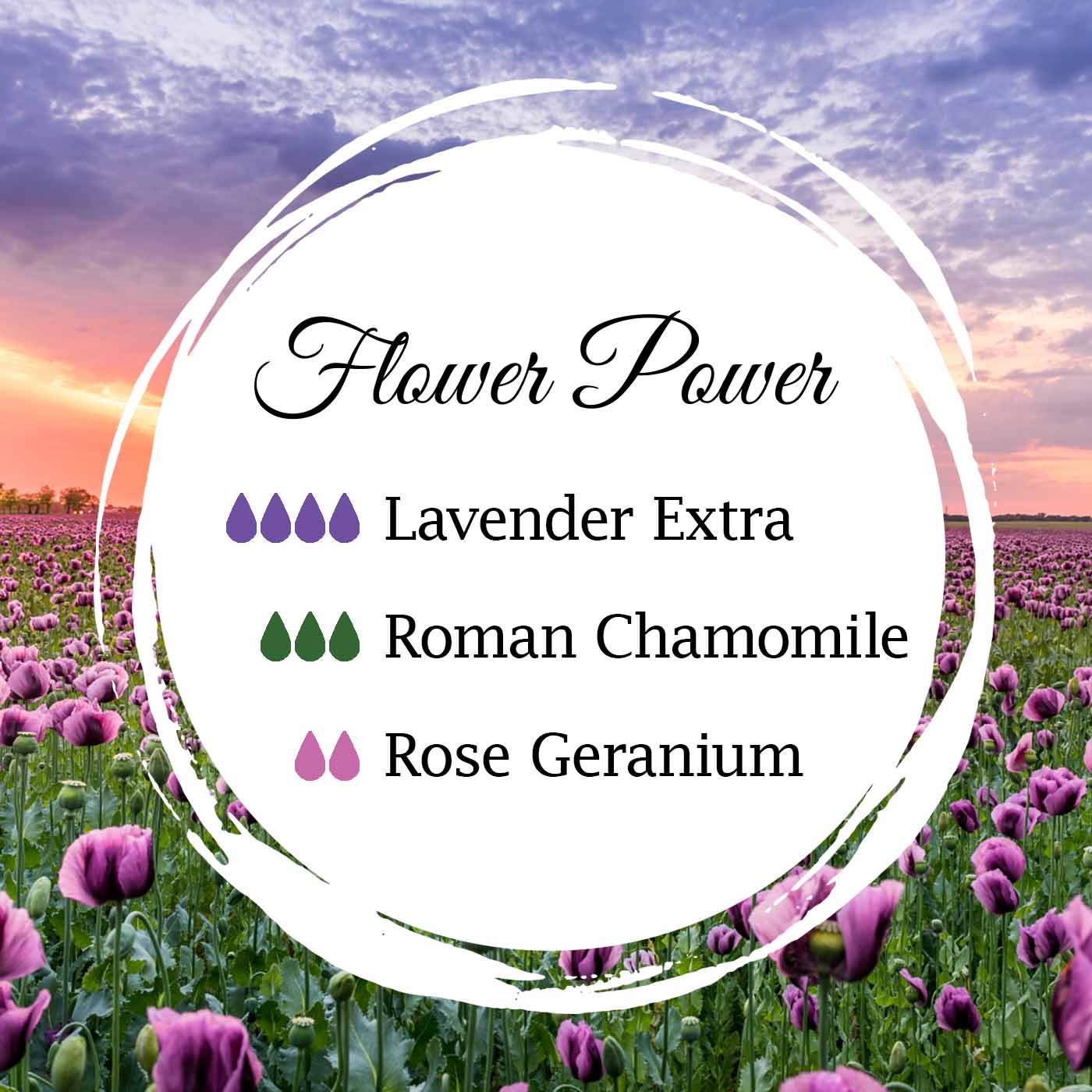 |
Final Thoughts from the Amrita Team
While it is understandable that offering so many distinct types of Chamomile Essential Oil could be confusing to some, Amrita also respects our enthusiastic customers (like you) enough to know that they would just as soon not be short-changed when it comes to options. Most “aromatherapy” companies only offer one type of chamomile product, maybe two. And they probably don’t take the time to explain which type(s) and why. Amrita sincerely hopes that this article will help you, as an avid user of essential oils, to better understand Chamomile products, enjoy their unique variety of options, and definitely want to come back for more!
Happy Blending!
*These statements have not been evaluated by the Food and Drug Administration. These products are not intended to diagnose, treat, cure, or prevent any disease.

